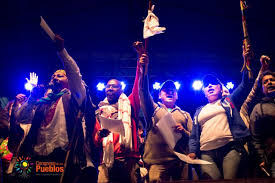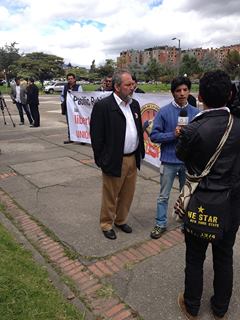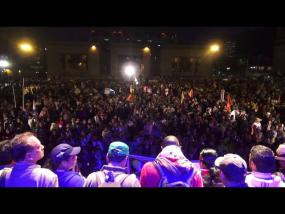October 2014
From the Peasant and Indigenous Strikes to the Popular, Ethnic, Agrarian Summit
The Peace talk and the peace process
Extractive Sector
Energy and the extractive sector have been a focal point for the Santos government for the peace negotiations in Havana. This is largely due to the fact that the major impetus behind peace negotiations with the guerrilla movements has been to stabilize the country in order to allow for companies to operate safely. Additionally, in the government's negotiations with social movements, issues involving energy and extractive companies are key. Failure of the government to meet the demands of social movements in this matter could result in a strike in these sectors in 2015.
In the past three years, rural communities have successfully used local referendums1 to reject mega-mining and petroleum projects. However, in 2013, the Colombian government issued Decree 934, which proclaimed some extractive projects to be in the “national interest”, thus taking away the jurisdiction of local authorities over them. Despite this, the Auditor General noted, in an official report, “Minería en Colombia Fundamentos para superar el modelo extractivista2” that Colombia’s participation in the multinational extractive sector was actually causing the country to lose capital and resources, due to tax exemptions .
Extraction and Militarization
Another crucial issue related to the extractive industry is the relationship it has with militarization. With the growth of the extractive sector in Colombia, there has been a sharp increase in the militarization of oil and mineral-rich territories, through the deployment of what are called Energy, Mining, and Transport Battalions. In 2011, there were only eleven Energy, Mining, and Transport Battalions; in 2014, there are twenty-one. Combined, these battalions make up 80,000 troops, which accounts for 37% of all land-based Army forces, and almost 30% of the entire National Armed Forces. To elucidate this relationship further, it must be noted that multinational extractive companies actually pay the Colombian government for the services of these battalions.
The mass militarization of extractive zones has not created greater security for the surrounding communities. In a report from 2009, Censat Agua Viva and Mining Watch Canada warned that 'the regions rich in resources are the source of 87% of forced displacements, 82% of human rights and international humanitarian law violations, and account for 83% of all assassinations of labour union leaders3. The purpose of these units is not to provide public safety but to safeguard foreign investment and the mining and energy extraction.
The latest developments in the extractive sector in Colombia are similar to what we are currently confronting in North America: EcoPetrol, colombian principal oil company still public in somways has proposed tar sands projects, and the Colombian congress has approved development of fracking. Among other problems, these developments pose a serious threat to the environment.
From the Peasant and Indigenous Strikes to the Popular, Ethnic, Agrarian Summit4
 The Popular, Ethnic, Agrarian Summit is part of an ongoing attempt by Colombia’s social movements to provide space for people to articulate the problems they are facing, and to collectively create solutions for a new order in the country. This process grew out of the agrarian strikes of 2013, when campesinos took to the streets to demand an end to : displacement; the exploitation of labour; land and resource expropriation; and international free trade agreements. Campesinos also demanded the right to a dignified life.
The Popular, Ethnic, Agrarian Summit is part of an ongoing attempt by Colombia’s social movements to provide space for people to articulate the problems they are facing, and to collectively create solutions for a new order in the country. This process grew out of the agrarian strikes of 2013, when campesinos took to the streets to demand an end to : displacement; the exploitation of labour; land and resource expropriation; and international free trade agreements. Campesinos also demanded the right to a dignified life.
The economic situation for small farmers in Colombia drastically deteriorated in 2011, when the Free Trade Agreement (FTA)5 between the United States and Colombia was signed, and the FTA with Canada was implemented. Between 2011 and 2013, agricultural imports to Colombia increased by 70%. Colombia now imports large quantities of cheap rice, corn, potatoes, meat, chicken and milk from the U.S. and Canada—products6 that small farmers in Colombia produce.
Free Trade Agreements have also strengthened the agro-industrial sector within Colombia and encouraged the cultivation of monoculture cash crops, such as African palm oil and wood on large-scale plantations. African palm oil has been at the center of the cash crop boom because it is an agrofuel. However, its cultivation has important negative impacts on the lives of campesinos.
Another major mobilizing issue for campesinos, directly related to the above-mentioned Free Trade Agreements, was the issue of seeds. In 2010, the Colombian government passed Resolution 970, which forced campesinos with more than 5 hectares of land to purchase certified seeds. This law was enforced through the use of riot police, who destroyed people’s seeds for not being properly certified or stored under ICA (Instituto Colombiano Agropecuario) criteria. Many campesinos were against using the certified, imported, genetically modified seeds in exchange for their traditional seeds, which they have been using for hundreds of years.
The agrarian strike began on August 19, 2013. Campesinos from the petroleum, small-scale mining, potato, milk and coffee sectors mobilized in 22 departments (provinces) across the country. Campesinos and their allies participated in a variety of actions, such as long-term roadblocks on highways and marches in Colombia’s major cities. Mobilizations during the strike resulted in 19 deaths, 600 people injured and hundreds of people detained.
The government responded to the strike with “The Pact for Agrarian and Rural Development”, which was essentially a development program for the agro-industrial elites, favoring the industrial cultivation of exportable monoculture cash crops, while largely ignoring the problems of small subsistence farmers. The minister of agriculture recently claimed, “I am not a friend of the poor campesinos [farmers] who only farm for self-support and no more.” Given that the strike was realized by small farmers whose livelihoods have been threatened by Free Trade Agreements and agro-industrial production, this pact was widely criticized and rejected by social movements.
The current goal of the campesino movement is to gain recognition as political actors, and to ensure the protection of their territories. Some campesino groups are calling for “Zonas de Reservas Campesinas,” or campesino reserves, a legal tool for protecting peasant land in ways similar to the collective territories of Indigenous and Afro-Colombian communities. Others are asking for agricultural reserves that could be inter-ethnic in order to avoid conflict with Afro- Colombian and Indigenous groups with competing claims to the land. On September 11th, 2014, negotiations between the Popular, Ethnic, Agrarian Summit and the Colombian government officially started; they could continue for a long time to come.
Right now the Summit’s organization needs support in order to put pressure on the government so that negotiations continue. They need an international protection network because their leaders are exposed and they need money and technical support on many economical, political and legal issues.
The Peace talk and the peace process
Colombian social movements have always argued for a negotiated solution to the social and armed conflict in Colombia. The talks that began in Havana two years ago are a source of hope for Colombians, many of whom see the peace process as more than a series of negotiations with the FARC. In the past two years, social movements have organized into several coalitions to ensure that they will have a voice in the peace process. One such coalition is “Clamor Social Por la Paz”, which is a convergence of churches, social organizations and victims organizations. Another coalition is “Frente amplio por la Paz” which is more of a political platform. They both have worked together on organizing national forums for peace, and their demands include an immediate cease fire, the opening of a real negotiation process with the ELN (Ejercito de Liberación Nacional) and EPL (Ejercito Popular de Liberación), and an agenda to reach real social peace.
What does a peace agenda from social movements look like?
The mechanisms for social participation in the peace talks in Havana are very limited. They include online comments, a few representatives going to Cuba, and forums organized by the UN for each point of the “official agenda.” Social movements have their own agenda for peace, because, despite the fact that the negotiations in Havana are only addressing the armed aspect of conflict in Colombia, there remains a very important social conflict. Additionally, the Santos government has repeatedly said that it will not negotiate a change to the economic model of the country. Unfortunately, the existence of this economic model and land rights are the two major roots of the armed conflict. Thus, in order to create a lasting peace, these root issues must be resolved.
In order to achieve peace, social movements have mobilized through the above-mentioned Popular, Ethnic, Agrarian Summit, general strikes and on-going negotiations with the government. They have also focused on humanitarian issues like the prison situation in Colombia, conflict resolution on the ground, and the safe removal of land mines.
To Colombian social movements, it is very clear that the country is far away from reaching a post-conflict status, despite the fact that the government has pushed this idea to foreign capital and donors in order to encourage investment. While the government talks about post-conflict and peace, it is simultaneously building new military bases and releasing paramilitary leaders from jail. Other signs of continued conflict include the fact that: the war profiteer and paramilitary ex-president Alvaro Uribe is now a senator in the Colombian national congress; human rights defenders and unionists are still receiving attacks and threats daily; and the armed conflict is more active than ever in Arauca, Catatumbo, and Putumayo. In the third trimester of 2014 there was a 234% increase in threats against Human Rights defenders in Colombia; 74% of the threats were from Paramilitary groups, 22% from unknown actors, 2% from the ELN guerrilla group, and 0.5% from the FARC guerrilla group.7
Another huge problem is the land restitution crisis. In 2011, Law 1448 established and confered a 10-year mandate to the Land Restitution Unit. The Colombian government declared it had until 2021 to redistribute 2 million of the nearly 7 million hectares of stolen land. However, over the past three years the government has only resolved 854 cases, which represents a total of 18,464 hectares. At this rate, it will take 90 years to complete the Land Restitution Unit's stated goal.
Many critics of Law 1448, and the process resulting from it, have stated that most of the zones given priority for restitution are of interest to the extractive industry. For example, in the Meta department, many residents were forced out of their homes by the Land Restitution process because, as they were not displaced when the area was controlled by the FARC, they were considered “illegal occupants”. Once the new owners receive this land through the restitution process, they often sell it to extractive companies, like Pacific Rubiales. It is interesting to note that the Canadian government proudly invests in the land restitution program. One could speculate that they see it as a good way for mining and oil companies to secure property.
Political Prisoners
In the context of the peace processes with the Farc-EP and the ELN, the prison movement in Colombia is demanding more recognition of political prisoners as victims of the conflict, and an end violations of the human rights of incarcerated people.
Prisons in Colombia are a clear reflection of the implementation of state policies that criminalize poverty and every expression of non-conformity. The more than 120,000 incarcerated men and women in Colombia face overcrowding and limited access to adequate food and health care. Of those incarcerated, 7,500 are political prisoners.
Networks like the National Prison Movement, which is comprised of political prisoners and other incarcerated people, are fighting to improve the abhorrent conditions in Colombia’s penitentiary system and protect the mental and physical integrity of prisoners. Support from international organizations is crucial; it can even mean the difference between life and death in many cases.
Several show cases have support from internacional campaigns like USO political prisoners, Miguel Beltran, teache at the Nacional Univeristy or Lilliany Obando in their case and many others, internacional unions and NGO campaign's had made a diference by raising the profile of specific cases with a letter or a phone call. 8
Labor movement
Information based on PASO International report Legal persecution continues to have a major impact on the Colombian labor movement. CUT, the largest labor federation in Colombia, offered the following words in their recent VI Congress Political Declaration: “We denounce the unfounded prosecutions that target union leaders exemplified by the case of CUT Executive Committee member Huber Ballesteros. Like Ballesteros, more than a hundred trade unionists are currently in prison”9. Labor and political opposition leader David Ravelo has been imprisoned for over four years despite clear irregularities in legal proceedings.
Legal persecution continues to have a major impact on the Colombian labor movement. CUT, the largest labor federation in Colombia, offered the following words in their recent VI Congress Political Declaration: “We denounce the unfounded prosecutions that target union leaders exemplified by the case of CUT Executive Committee member Huber Ballesteros. Like Ballesteros, more than a hundred trade unionists are currently in prison”9. Labor and political opposition leader David Ravelo has been imprisoned for over four years despite clear irregularities in legal proceedings.
With regards to antiunion violence, the National Labor School offered the following insight in a September, 2014 report:
Between January 1, 2013 and August 15, 2014 some 45 violations of personal liberty and physical integrity were registered targeting members of [national oil and energy sector union] USO, among others two homicides and 29 threats. This illustrates high risk levels associated with union-related activities in the oil industry, a sector in which Canadian companies play a major role, particularly in the region of Puerto Gaitan, Meta where the influence of Canada’s most lucrative company in Colombia, Pacific Rubiales Energy (PRE), is almost absolute. In this region, during the past three years (since the FTA with Canada went into effect) USO members and leaders have been the victims of 24 violations including threats, harassment, arbitrary arrests, and one homicide... [The union also] has been confronted with 32 criminal processes targeting its leaders, members, and activists due to these individuals’ involvement in protests [in Puerto Gaitan in 2011] responding to PRE’s refusal to accept unionization and collective bargaining in the Rubiales Field. The seriousness of these violations at the hands of PRE deserves a concrete governmental response so that conflicts can be resolved, responsible parties (including the company) sanctioned, and comprehensive redress provided for the union and its members (including families) personally affected by these violations10.
The ENS report, meanwhile, also points out that unions exist in only three of the 52 Canadian companies present in Colombia, the vast majority of which participate in the mining and energy sector, and that a collective bargaining agreement has been signed with workers in only one. It goes on to discuss a number of specific regional situations involving Canadian companies, painting a general picture in which environmental degradation, human rights abuses, labor violations, and conflict feature prominently11.
The newly appointed Colombian Labor Minister has indicated an institutional intention to address labor formalization in several key areas including the oil/energy and port sectors (among others). This is a welcome announcement given that national oil company Ecopetrol outsources 82% of its workers12 and that PASO's research in the ports of Buenaventura has revealed an appalling network of illegal subcontracting, wage theft, pension theft, dangerous working conditions, inhumane living conditions, and retaliation against workers who exercise their legal right to join a union. Recently primary port operators have refused to receive union affiliation forms, and it is commonplace to encounter workers sleeping in the street at the port’s gate.
1 On this subject http://www.pasc.ca/fr/node/4536
2 http://censat.org/es/publicaciones/mineria-en-colombia-fundamentos-para-superar-el-modelo- extractivista
3 Land and Conflict Report prepared for Interpares September 2009 https://www.interpares.ca/sites/default/files/resources/2009-
09LandAndConflictResourceExtractionHumanRightsAndCorporateSocialResponsibility.pdf
4 Based on PASC member online publication http://youngist.org/popular-agrarian-summit-calls-for- strike-colombia/#.VDga_NTF_DE
The Popular, Ethnic, Agrarian Summit is made up of the following organizations:
La Organización Nacional Indígena de Colombia (The National Indigenous Organization of Colombia) -ONIC, el Coordinador Nacional Agrario (National Agrarian Coordinator) -CNA, el Congreso de los Pueblos, la Mesa de Interlocución y Acuerdos (The Roundtable of Dialogue and Agreements) -MIA, Marcha Patriótica, el Proceso de Comunidades Negras (The Process of Afro Communities) -PCN, la Mesa de Unidad Agraria (The Roundtable of Agrarian Unity) -MUA, la Asocación Nacional de Zonas de Reserva Campesina (The National Association of Reserved Campesina Zones) -ANZORC, la Coalición de Organizaciones y Movimientos Sociales de Colombia (The Coalition of Social Movements and Organizations in Colombia) -COMOSOC, and la Federación Nacional Sindical Unitaria Agropecuaria (National United Agriculture and
Livestock Syndicalist Federation) -FENSUAGRO.
The Demands of the The Popular, Ethnic, Agrarian Summit:
http://congresodelospueblos.org/index.php/pueblo-en-lucha/cumbre-agraria/484-pliego-de- exigencias-de-la-cumbre-agraria
http://prensarural.org/spip/spip.php?article13670
Political Statement of the Summit:
Spanish : http://cms.onic.org.co/2014/04/declaracion-politica-cumbre-agraria-campesina-etnica- y-popular/
English: http://www.pasc.ca/fr/node/4705
5 See http://youngist.org/mi-tierra-no-se-vende/
6 See http://www.telesurtv.net/articulos/2013/08/19/campesinos-arruinados-por-las-importaciones-y- politicas-del-tratado-de-libre-comercio-3155.html
7 (october 2014 ) http://www.contagioradio.com/index.php? option=com_content&view=article&id=8240%3Aen-tercer-trimestre-de-2014-aumentaron-en-un-234- las-amenazas-contra-defensores-de-derechos-humanos-en-colombia&catid=8%3Aotra- mirada&Itemid=2
8 More on Political prisonners http://www.pasc.ca/en/cam/political-prisoners
9 See http://cut.org.co/declaracion-politica-del-sexto-congreso-de-la-cut/ for complete statement.
10 Tres años del TLC con Canadá: concentración sectorial, impacto socio-económico y comportamiento laboral, ENS, September, 2014 (http://www.ens.org.co/index.shtml?apc=Na--;1;-;-;&x=20170182).
11 Ibid.
12 Condiciones laborales en las 22 empresas más poderosas del país: Tercerización a gran escala y baja sindicalización la tendencia, Edwin Mauricio Villamil Garzón, Escuela Nacional Sindical, February,
2014 (http://www.ens.org.co/index.shtml?apc=ba--;1;-;-;&x=20168681).
